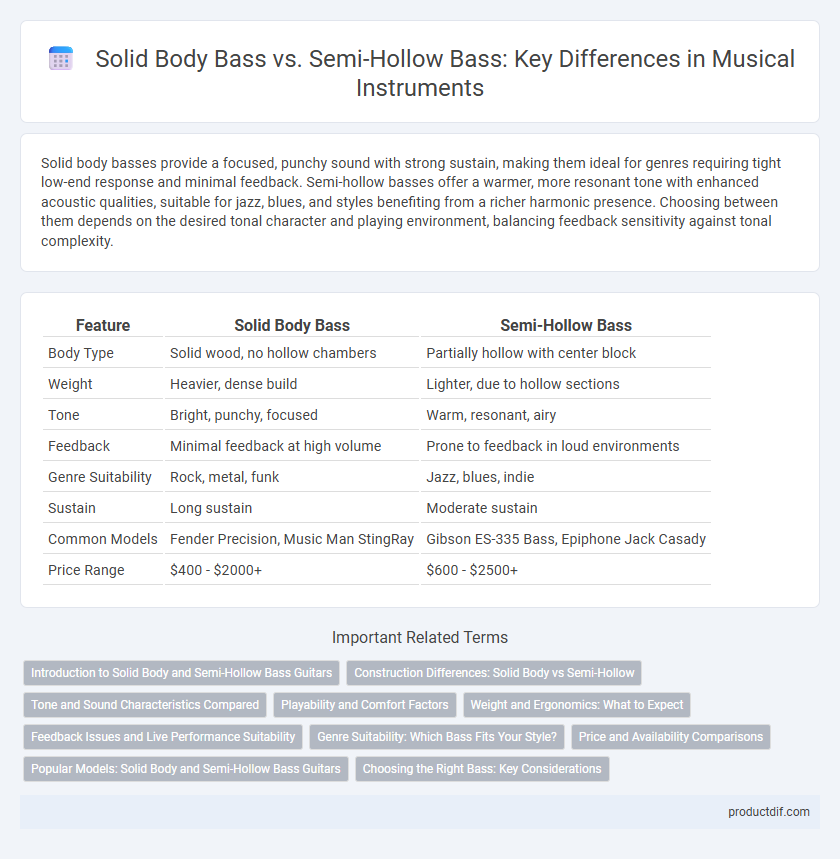Solid body basses provide a focused, punchy sound with strong sustain, making them ideal for genres requiring tight low-end response and minimal feedback. Semi-hollow basses offer a warmer, more resonant tone with enhanced acoustic qualities, suitable for jazz, blues, and styles benefiting from a richer harmonic presence. Choosing between them depends on the desired tonal character and playing environment, balancing feedback sensitivity against tonal complexity.
Table of Comparison
| Feature | Solid Body Bass | Semi-Hollow Bass |
|---|---|---|
| Body Type | Solid wood, no hollow chambers | Partially hollow with center block |
| Weight | Heavier, dense build | Lighter, due to hollow sections |
| Tone | Bright, punchy, focused | Warm, resonant, airy |
| Feedback | Minimal feedback at high volume | Prone to feedback in loud environments |
| Genre Suitability | Rock, metal, funk | Jazz, blues, indie |
| Sustain | Long sustain | Moderate sustain |
| Common Models | Fender Precision, Music Man StingRay | Gibson ES-335 Bass, Epiphone Jack Casady |
| Price Range | $400 - $2000+ | $600 - $2500+ |
Introduction to Solid Body and Semi-Hollow Bass Guitars
Solid body bass guitars feature a solid wood construction that provides sustain, feedback resistance, and a focused tonal output ideal for diverse music genres. Semi-hollow bass guitars incorporate a partially hollow body with internal chambers, delivering a warmer, resonant tone with enhanced acoustic qualities and reduced weight. Both designs influence playability and sound character, catering to different stylistic preferences and performance environments.
Construction Differences: Solid Body vs Semi-Hollow
Solid body bass guitars are constructed with a dense, solid piece of wood that offers sustain and resistance to feedback, making them ideal for various music genres. Semi-hollow basses feature a partially hollow body with internal chambers and f-holes, providing a warmer, more resonant tone but increased susceptibility to feedback at high volumes. The difference in construction directly impacts the bass's tonal characteristics, weight, and performance in live and studio settings.
Tone and Sound Characteristics Compared
Solid body basses deliver a punchy, focused tone with strong sustain and minimal feedback, ideal for genres requiring clarity and definition such as rock and metal. Semi-hollow basses offer a warmer, more resonant sound with natural acoustic qualities and slight feedback, favored in jazz, blues, and fusion for their rich harmonic complexity. The choice between the two depends on the desired tonal palette: solid bodies emphasize precision and brightness, while semi-hollows provide depth and airy warmth.
Playability and Comfort Factors
Solid body bass guitars offer superior playability with reduced feedback and increased sustain, making them ideal for aggressive or high-gain playing styles. Semi-hollow basses provide a lighter weight and more ergonomic contouring, enhancing comfort for extended playing sessions and delivering a warmer, more resonant tone. Choosing between the two depends on the player's preference for either a stable, punchy feel or a more airy, comfortable instrument suited for diverse musical expressions.
Weight and Ergonomics: What to Expect
Solid body bass guitars are typically heavier due to their dense wood construction, offering increased sustain but potentially causing more fatigue during long playing sessions. Semi-hollow basses feature a lighter frame with hollow chambers that reduce weight and improve ergonomic comfort, making them ideal for extended use and stage performances. Musicians seeking portability and ease of play often prefer semi-hollow models for their balance between tone and ergonomic design.
Feedback Issues and Live Performance Suitability
Solid body bass guitars resist feedback effectively due to their dense, non-resonant construction, making them ideal for high-volume live performances. Semi-hollow basses, featuring partially hollow chambers, tend to produce richer, warmer tones but are more prone to feedback, especially at elevated sound levels. Musicians performing live in loud environments commonly favor solid body basses for their stability and feedback resistance.
Genre Suitability: Which Bass Fits Your Style?
Solid body bass guitars excel in genres requiring tight, punchy tones such as rock, metal, and funk, delivering powerful sustain and minimal feedback. Semi-hollow basses provide warm, resonant sounds ideal for jazz, blues, and indie music, offering enhanced acoustic qualities and reduced weight. Selecting between solid body and semi-hollow depends on the desired tonal characteristics and genre-specific sound dynamics.
Price and Availability Comparisons
Solid body bass guitars generally offer a more affordable price range due to mass production and widespread availability, making them accessible to beginner and intermediate players. Semi-hollow basses tend to be pricier, reflecting their complex construction and niche market, often found through specialized retailers and custom shops. Availability of semi-hollow models is limited compared to solid body basses, which dominate music stores and online platforms worldwide.
Popular Models: Solid Body and Semi-Hollow Bass Guitars
Popular solid body bass guitars include the Fender Precision Bass and the Music Man StingRay, known for their punchy tone and strong sustain ideal for rock and funk genres. Semi-hollow bass models such as the Epiphone Jack Casady and Gibson EB-2 offer warm, resonant sounds with reduced feedback, favored in jazz and blues. Each design influences tonal characteristics and playing style, with solid bodies providing clarity and semi-hollows delivering rich harmonic complexity.
Choosing the Right Bass: Key Considerations
Selecting the right bass involves evaluating tonal characteristics and playing environments; solid body basses offer strong sustain and resistance to feedback, ideal for genres requiring punchy, precise sounds. Semi-hollow basses provide warm, resonant tones with enhanced acoustic qualities, suited for jazz and blues where organic sound is paramount. Consider weight, feedback sensitivity, and genre compatibility when deciding between solid body and semi-hollow bass guitars.
Solid Body Bass vs Semi-Hollow Bass Infographic

 productdif.com
productdif.com